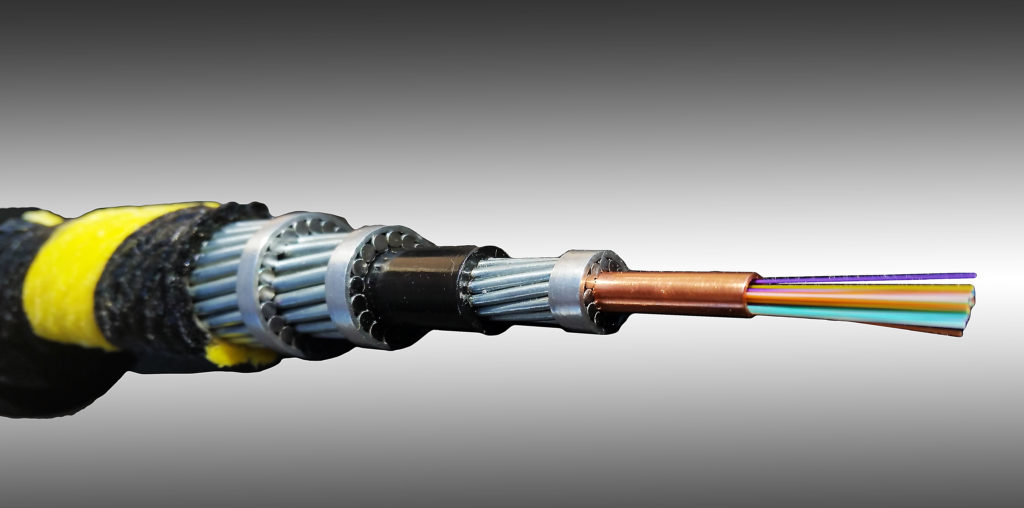
A vessel lays the fiber-optic cable near Smugglers Cove close to Skagway. (Courtesy AP&T)
Alaska Power and Telephone broadband internet customers will start to see impacts from a newly-installed fiber-optic cable this month. The power company took on the multi-million dollar fiber project to expand its internet capacity in the Northern Lynn Canal. AP&T says it’s about 1,500 customers will get their first taste of significantly faster internet connections this month. But there is still work to be done.
“The road ahead in Southeast Alaska is growing,” a promotional video from AP&T touts the $11 million investment the company made to lay an 86-mile fiber-optic cable in the Lynn Canal.
Until now, AP&T customers in Haines and Skagway were connected to the internet through a microwave network. The fiber-optic cable exponentially increases internet capacity.
“As we plan to grow our speeds to 10 Megabit, 20 Megabit and higher, the microwave network could not sustain that growth.” said CEO Mike Garrett in the video.

A view of the fiber-optic cable. (Courtesy AP&T)
The company’s first iteration of faster plans come online this month.
“Things are changing pretty dramatically in terms of what’s available,” said Bryant Smith, AP&T’s director of internet services.
On January 25, a suite of new broadband internet packages will become available. The current retail packages are limited to 8 Megabit download speeds and 200 gigabyte data usage caps. Those are the very top ranges of what’s available for most customers. Although AP&T does offer custom packages to businesses who need more capacity.
But now, the highest download speeds will spike to 25 Megabits. And the data limit increases three-fold, to 600 gigabytes.
It’s still a lot more restricted, and pricey, than what residents in Seattle, Anchorage and Juneau have access to, but it’s a significant increase from the current offerings.
One reason for the remaining limitations is that AP&T is rolling out these new packages before the fiber-optic infrastructure is complete. The company still needs to install the on-the-ground connections that will link to the undersea cable. Right now, homes and businesses are connected to the fiber-optic line with older, copper wires.
“Some of the outside plant that’s in the air in those two communities may not efficiently support the types of speeds that we’re going to want to provide to customers,” said AP&T Director of Marketing Mark McCready. “So AP&T has committed to upwards of $1.5 million to hang glass in the communities.”
Once homes and businesses are more directly connected to fiber-optic lines, Smith says internet speeds could increase even further.
“A lot of the fiber to the home or fiber to the business work that we’re going to be doing is to prepare us to offer those higher speeds,” said Smith. “We’re at the limit of what we can do over a copper line and so if we’re going to be a on a path to offer an 100 [Megabit] connection to people’s homes we’ve got to have that local build completed. And I think for Haines and Skagway that local build’s probably going to take 3-4 years to complete.”
Smith says introducing faster packages before the fiber web is complete will push the older, copper infrastructure ‘to the limit.’ And he says even once all the glass connections are in the air, some customers may still be limited based on the infrastructure in their homes or the neighborhoods they live in, if they’re more remote.
“If you’ve got a dozen people who live 30 miles out the road in Haines, it’s not likely that we’re going to spend a million dollars to make sure that they could get the 25 [Megabit.]”
On Jan. 25, current AP&T customers will automatically be shifted to better internet packages, based on what they already pay. For example, if you pay $79.95 a month for 1 Megabit download speeds with a 40 gigabyte data cap, your plan will change to 10 Megabit download speeds with a 150 gig data cap.
A phone line is still required to get internet service, although that’s something AP&T is working toward changing in the future.
Below is a FAQ provided by AP&T that details new internet packages:
Question: What will the new broadband tiers be in Haines, Skagway and Klukwan?
Answer: We will be marketing 4 primary broadband tiers to business and residential customers. Each of the 4 tiers are upgradable in terms of the usage element for an additional fee. On our side as the provider, it’s just 8 choices and here they are:
5Mb download/1Mb upload with 150GB data cap for $49.95 a month < marketed as the tier
5Mb/1Mb with 300GB for $89.95 a month < marketed as an add-on of 150GB for $40.00
10Mb/1Mb with 150GB for $79.95 a month < marketed as the tier
10Mb/1Mb with 300GB for $119.95 a month < marketed as an add-on of 150GB for $40.00
15Mb/1Mb with 150GB for $99.95 a month < marketed as the tier
15Mb/1Mb with 300GB for $139.95 a month < marketed as an add-on of 150GB for $40.00
25Mb/1Mb with 300GB for $159.95 a month < marketed as the tier
25Mb/1Mb with 600GB for $229.95 a month < marketed as an add-on of 300GB for $70.00
There will be a few Business tiers that become available around March and of course we will still work with businesses on custom tiers as well.
Question: When will the new broadband tiers be available?
Answer: We will be moving existing broadband subscribers to the new tiers based upon the current monthly rate the customer is paying being equal or less than the new tier and that will happen on January 25, 2017. Of course new customers will have access to the new tiers effective that date as well.










Why not a 20Mb speed with a 600 Gb cap offering?